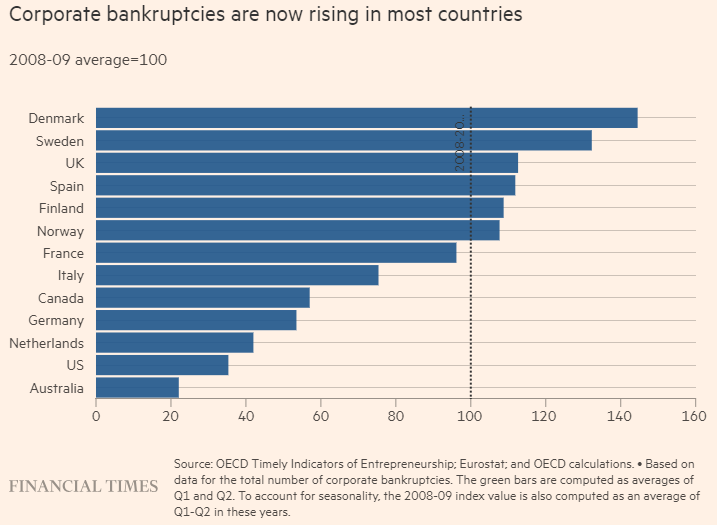- The number of US corporate bankruptcies rose 30 percent in the 12 months to September compared with the year-ago period, according to court data.
- Corporate bankruptcies are increasing at double-digit rates in most advanced economies as borrowing costs rise and governments unwind pandemic-era measures to support businesses worth trillions of dollars.
- “We observe the rise in corporate insolvency in almost all countries of the world,” said Maxime Lemerle, lead analyst for insolvency research at Allianz Research.
‘Zombie’ companies lose lifeline as increased borrowing costs compound withdrawal of pandemic-era support
Corporate bankruptcies are increasing at double-digit rates in most advanced economies as borrowing costs rise and governments unwind pandemic-era measures to support businesses worth trillions of dollars.
Following a decade of decline, the number of US corporate bankruptcies rose 30 percent in the 12 months to September compared with the year-ago period, according to court data.
Germany, the EU’s largest economy, said bankruptcies rose 25 percent from January to September compared with the year-ago period. Since June, monthly “double-digit growth rates have been consistently observed compared to the previous year”, the country’s statistical office Destatis said on Tuesday.
Across the bloc, corporate insolvencies rose 13 percent year on year in the nine months to September to reach their highest level in eight years, according to Eurostat.
Higher interest rates, along with the collapse of zombie companies that had survived on Covid-era government support, have fueled the trend, according to Neil Shearing, chief economist at Capital Economics.
Shearing cited “the cost of debt servicing” and “the rollback of pandemic support” as well as “high energy bills, particularly in energy-intensive sectors”. The industries suffering the most from the increased insolvency rates included transportation and hospitality, analysts said.

Businesses weathered the precipitous downturns triggered by the pandemic thanks to massive government support schemes for companies and households that amounted to more than $10tn, according to IMF estimates for 2020 and the first four months of 2021. But since then, the packages have been largely withdrawn.
Shearing warned that the trend was set to continue as many businesses will have to refinance debt at higher rates in the coming months, even if central banks’ rate rises are forecast to have peaked.
The surge in bankruptcies will weigh on global economic activity and job growth in the next few years, according to analysts.
Susannah Streeter, senior investment analyst at asset manager Hargreaves Lansdown, said that while the rise was partly due to zombie companies folding, “the concern is that the rapid tightening in monetary policy will also push more promising start-ups and SMEs over the edge, which could have longer-term consequences for growth”.

Rating agency Moody’s expects the global speculative-grade default rate to continue to increase in 2024 after reaching 4.5 percent in the 12 months to October, above the historical average of 4.1 percent.
David Hamilton, head of research and analytics at Moody’s, said that “credit [will be] either materially more expensive than it was or simply harder to come by”.
Moody’s cited the recent default of Rite Aid, which operated more than 2,300 pharmacies across 17 US states, and the distressed debt exchanges of Belgian consumer goods company Ideal Standard International and UK business services group Haya Holdco 2.
German financial services company Allianz forecast that global insolvency growth rates would hit 10 percent next year, after increasing by 6 percent in 2023.
“We observe the rise in corporate insolvency in almost all countries of the world,” said Maxime Lemerle, lead analyst for insolvency research at Allianz Research.

In France, the Netherlands and Japan, bankruptcies were up more than 30 per cent year on year in October, according to national statistics offices. The Paris-based OECD group of mostly rich nations recently noted that in some countries — including Nordic nations Denmark, Sweden, and Finland — corporate bankruptcy rates have exceeded levels during the 2008-09 global financial crisis.
In England and Wales, insolvencies for the January-September period had also hit their highest level since 2009, according to the Insolvency Service.
The labor-intensive hospitality, transportation, and retail sectors have been hit hardest; Allianz warned. It said industries that were more sensitive to interest rate rises, such as real estate and construction, were expected to come under strain too.
However, energy subsidies and other measures would help keep many businesses afloat, meaning the peak in insolvencies was unlikely to be as high as in previous corporate downturns, analysts said.
Many businesses accumulated good cash buffers and secured cheap financing deals when rates were low. The global economy is forecast to continue growing and unemployment rates are historically low in most large economies.
“We are not saying that we are facing a tsunami of insolvencies,” he said.
Bankruptcy numbers remain modest by historical standards in big economies including the US, Germany, and France, analysts added.
Story by Valentina Romei - Redacted shorter to keep to important points and bullet points added by HGG https://www.ft.com/content/a02cb631-8ae4-4ac2-be45-edfa776ed75f

